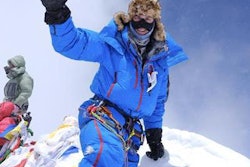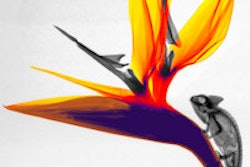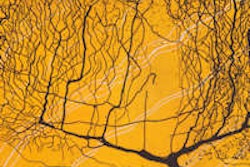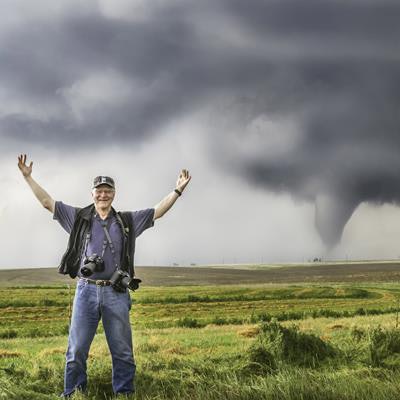
Everyone has a way to unwind after a busy workday -- but for most radiologists, it probably doesn't include chasing tornadoes. Nebraska radiologist Dr. Derek Burdeny is the exception, tracking storms and photographing them up close and personal across the U.S.
Burdeny began chasing storms about six years ago, and over the past year alone he has photographed 23 tornadoes, he said. Getting these photos can mean a weekend trip into, say, Montana or Texas, or even a quick weekday drive after work to a closer spot, returning home late that night but heading back to the world of radiology the next day.
"Radiology is my day job, so [photography] has always been a side thing, a hobby," he said. "But it's become more of a pleasurable hobby now and more of an intense hobby. Now it's my No. 1 passion, outside of radiology."
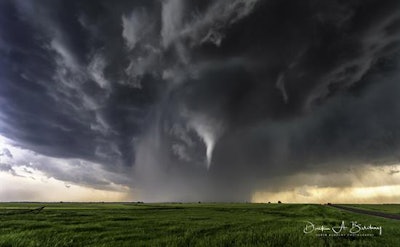 A tornado in Caldwell, KS. All images courtesy of Dr. Derek Burdeny.
A tornado in Caldwell, KS. All images courtesy of Dr. Derek Burdeny.Living in tornado alley
Burdeny's interest in photography predates his adventures in storm chasing. He's been taking photos for decades, initially bringing along a 35-mm camera on his travels.
At the same time, as a resident of Nebraska, it's hard to avoid the Midwest's turbulent weather.
"Storms have always interested me. Especially tornadoes," he said. "We live in tornado alley here, and there are lots of storms, so you have to be aware of [them]."
Most people's usual reaction, though, is to move away from tornadoes -- not toward them -- so he had never actually seen one before he began chasing them, he added.
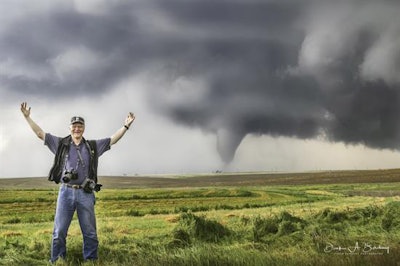 Burdeny with a tornado spotted near Dodge City, KS.
Burdeny with a tornado spotted near Dodge City, KS.His storm-chasing trips arose from a conversation with a friend, who asked if he wanted to join him and see a tornado in person. Burdeny's interest was piqued.
"The first time we did it we went to Kansas, almost to the Oklahoma border, and saw this really beautiful tornado," he said. "It was just so pretty, and I've been hooked ever since."
Moving in for the close-up
The early season for storms begins around February, Burdeny explained, with May being the peak time. The major storm locations tend to move from south to north during the season, shifting from spots like Texas early on, through the middle of the Midwest, and even perhaps into Canada.
He and a storm-chasing friend will study weather patterns using several forecasts and models, continually revising their analysis based on new data -- until it's just time to go.
"The day of, you pretty much just scrap the models," Burdeny said.
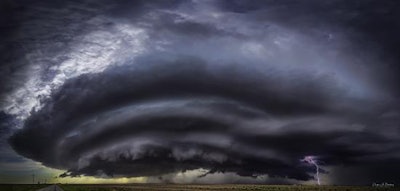 Burdeny's photo of a Texas supercell storm, titled "Nature's Fury," won third place in the 2016 "It's Amazing Out There" photo contest from the Weather Channel.
Burdeny's photo of a Texas supercell storm, titled "Nature's Fury," won third place in the 2016 "It's Amazing Out There" photo contest from the Weather Channel.When approaching storms, he tries to take two types of pictures. One is of supercells, a more dangerous type of thunderstorm characterized by rotating updrafts of air. The other is of the smaller tornadoes hanging off the supercells. But this means achieving a careful balance between two distances: Staying far away leads to great images of the supercell and structure, but getting close offers better pictures of the tornadoes, he said.
Sometimes Burdeny is able to get the tornado close-up; other times he and fellow chasers have had to move out of the path of the storm but then overshot, ending up too far away.
"But better safe than sorry," he emphasized. He hasn't found himself in any dangerous situations, he said.
Balancing storms and scans
Given the typical workday of a radiologist, it might seem hard to imagine having the flexibility for such adventures. Burdeny works in Omaha, specializing in musculoskeletal MRI with National Orthopedic Imaging Associates of Novato, CA. He credits his partners for the ability to follow his photography passion.
"My partners are the best in the world," he said. "They sort of understand this [interest], and they've allowed me to do these things. I couldn't ask for better partners or a better job than what I have right now. I'm very fortunate."
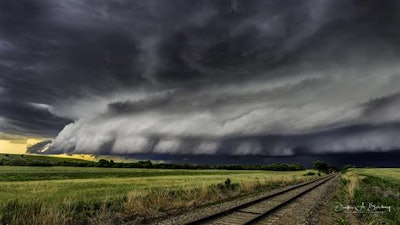 A shelf cloud and thunderstorm.
A shelf cloud and thunderstorm.Burdeny also credits digital photography for the quality of his work reaching a new level, after switching from the 35-mm camera to digital ones.
"Before digital came around, I just had fun taking pictures and I never really became good at it, because you didn't have instant feedback like you do with a digital camera," he said. "So I pretty much had one year of experience 30 times over, rather than 30 years of experience."
However, with the use of digital cameras, he began experimenting more and also learning more about photography, which eventually dovetailed with his pursuit of storms.
In a way, his separate passions of radiology and photography have also come together over the years, he said. For example, similar to the shift from film to digital in photography, the transition to digital imaging in radiology provides more control over images.
"I started radiology back in the film days before digital," he said. "So, pretty much, I read a study and the densities on the x-ray were what the technologist gave me. Just like the 35-mm pictures, where I got whatever the photo shop would give me back in return."
But when reading scans today, there's the option to window and level and get the desired image. The same is true for photography via Photoshop, though Burdeny said he doesn't make significant changes to his images. Both trends have led to more screen time, however.
"All day long I'm sitting at the hospital in front of a computer with the mouse, and at home, at night, I'm sitting in front of a computer with the mouse," he noted with a laugh.
The work seems to be paying off: Last year marked Burdeny's first entry into a photo contest, and his "Nature's Fury" image came away with third place among more than 66,000 entries in the Weather Channel competition. More of his storm-related photos, as well as other images, are available at 500px.com/dburdeny.




